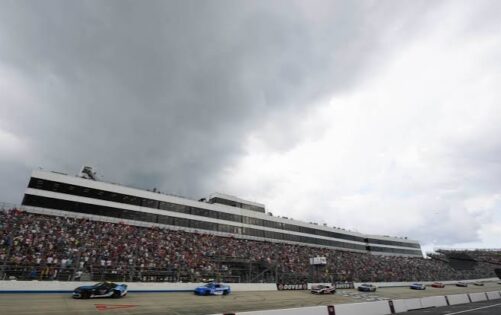When bursts of thunderstorms swept over Dover Motor Speedway last weekend, the grandstands and pit boxes all fixated on the clouds above, not just the cars roaring below. Rain, relentless and often unpredictable at Dover, again seized the headlines, forcing NASCAR to halt the race and upend the usual rhythm of competition. Track crews scrambled, drawing attention from drivers and fans who’ve seen the Monster Mile’s history repeatedly shaped by Mother Nature’s interruptions.
In the garages, teams weighed the benefits of risking a restart versus the exhaustion of another hours-long delay. The mood was a mixture of anticipation, frustration, and above all, uncertainty. Heading into those critical final laps, NASCAR’s leadership made the call to resume the event after about an hour of track drying, a decision that didn’t just determine who would take the checkered flag but also sparked a fierce debate among insiders, competitors, and spectators on how to manage racing’s showdown with the weather.
Insiders defend NASCAR’s swift Dover call amid criticism
NASCAR’s decision to resume the Cup Series race at Dover after a significant rain delay drew scrutiny, but one trusted insider, Bob Pockrass, defended the call as not just reasonable but essential. Speaking immediately after the finish, the insider emphasized, “It only took an hour to get the track ready, which was quite important, because everybody could see they were going to get to the finish pretty quickly after that storm. You knew you weren’t gonna be there for another two hours, and that would be the big question.” This pragmatic outlook echoed the logistics and realities that officials, teams, and fans at the venue had to face: with time slipping away before sunset, and no track lighting to allow a late finish, the window to end the race under green was shrinking fast.
With just 13 laps remaining, expanded by overtime restarts, the tension centered around whether resuming would risk the fan experience or uphold the integrity of the competition. “I think you gotta consider the people at the track, but considering everything on this one, it was a good decision,” the insider said, pointing out that fans had already endured the elements and a grueling day. Restarting promptly didn’t just serve television or team interests; it recognized the commitment of those on site and the importance of competition.
“NASCAR made the right move to dry the track to get to the finish. But what if it would have taken two hours?”
Fast Thoughts with @bobpockrass: pic.twitter.com/SK191yuQuH
— FOX: NASCAR (@NASCARONFOX) July 21, 2025
Some among the crowd and online called for the race to finish at any cost, arguing that failing to complete it under green falg would be a disservice to the fans. The inside voice acknowledged the presence of wipers on the cars and confirmed, “The track was good to go. Nobody will complain about them getting to the finishes, especially if you’re into competition.” The emphasis, repeated throughout, was on timely, transparent decision-making, balancing the unpredictable challenges of weather with the uncompromised spectacle of racing.
Further, Pockrass hinted that any alternative, such as waiting additional hours in the fading daylight, knowing there could be multiple overtimes, risked further alienating those who had invested the entirety of their day. “Is it worth waiting another two hours? I don’t know if it would have been…and then people even getting home later.” The numbers were clear: a prompt, focused effort ensured the race concluded with integrity and maximum fairness to competitors and fans alike.
Winner’s moment and what’s next for Dover
Ultimately, it was Denny Hamlin who capitalized best on the post-storm restart, locking down the victory at Dover. The strategy employed by his team, weighing the risk of late cautions and changing track conditions, paid enormous dividends. Hamlin’s win, marked by a strong charge on the overtime laps, reinforced the notion that NASCAR’s priority to compete to the full distance benefited not just the winner but also the spectacle for everyone watching. In the Xfinity Series, Ryan Truex’s emotional victory on Saturday added another layer to a weekend defined by weather adversity and perseverance, giving hometown fans a bright spot despite the stormy interruptions.
NASCAR, Motorsport, USA Wurth 400 presented by LIQUI MOLY May 4, 2025 Fort Worth, Texas, USA NASCAR Cup Series driver Denny Hamlin 11 is introduced before the start of the Wurth 400 race at Texas Motor Speedway. Fort Worth Texas Motor Speedway Texas USA, EDITORIAL USE ONLY PUBLICATIONxINxGERxSUIxAUTxONLY Copyright: xJeromexMironx 20250504_jpm_an4_M27486
NASCAR’s weather-responsive strategy in Dover must be viewed in the context of the track’s long-standing pattern of stormy interruptions, an issue so pronounced in recent years that rainouts and delays have become almost a tradition. In 2022 and 2023, persistent rain forced Cup races to carry over to Monday, silencing the track’s thunderous energy for hours or even a day. This time, while the Xfinity event was shortened slightly and Cup qualifying was canceled, NASCAR drew a line. The goal? To avoid consecutive days of delays and deliver closure for races meaningful to both playoff hopefuls and the broader fanbase.
Drivers and strategists faced dual challenges, adjusting on the fly as the weather broke and making the most of a tight restart window. The lack of track lighting at Dover heightened the stakes, as officials had only a brief post-storm window to safely complete the race. Ultimately, the pragmatic, competition-forward decision prioritizing safety, completion, and the fan experience set a crucial precedent for how NASCAR will handle future weather emergencies, especially at vulnerable venues like Dover.
The post Trusted Insider Backs NASCAR’s Weather Compromised Strategy at Dover Despite Some Backlash appeared first on EssentiallySports.
